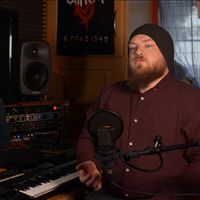17h ago (edited) in General 🤩
Panmanagement - a tool that makes your mix amazing
The soundstage is an extremely important aspect of mixing your audio, as it places the instruments on a mental stage that our ears all equate to. I was first taught to listen carefully with my eyes closed because I could see where they were in relation to each other and their surrounding environment when using [insert tool/s here]. Some tools make this job easier than others; however, if you won't stand out from others who use worse quality equipment, then understanding some basics will help tremendously! Nothing can ruin music faster than having bad mixdowns, so invest wisely by investing time into learning how to create a great soundstage for your audio mixes.
Your drumset is the backbone of your sound. The same applies when recording audio - you need to make sure that each and every piece of your kit is captured perfectly. This means placing microphones around your set in specific positions so that each element is accurately represented in the final mixdown. By using multiple microphones, you create a sense of depth and space that can be essential to getting the perfect sound for your music.
Having a good depth in relation to your audio recording is important so that people can hear what you are saying clearly. This can be achieved by using a good quality microphone and recording in a quiet environment. Another important factor to consider when it comes to audio recordings is the level of volume. Make sure that your recordings are not too quiet or too loud. It is important to think about the editing of your audio recordings. Even if you are recording in a high-quality environment with a great microphone, there may be some background noise that you want to remove. There are many software programs that can help you to edit your recordings and remove any unwanted noise. By taking the time to edit your recordings, you will ensure that they are clear and easy to listen to. By taking the time to consider the depth, volume and editing of your recordings, you will create recordings that are enjoyable and easy to listen to.
Sound waves travel much faster than the speed of sound. They can travel up to 10 times as fast! When you hear something, the sound wave has already passed by your ears and is on its way to the person or object that you heard it from.
Vibrations create sound waves. When something vibrates, it sets the air particles around it in motion. These particles bump into other air particles, which causes them to vibrate too. This chain reaction continues until the sound waves reach your ears.
The speed of sound is affected by the type of medium it travels through. For example, sound waves travel faster through solids than through gases. This is why you can hear someone talking from further away if they are standing on a hard surface, like concrete, than if they are standing on grass.
The speed of sound also changes depending on the temperature of the medium it is traveling through. Sound waves travel faster through hot air than they do through the cold air. This is why you can sometimes hear distant thunder before seeing the lightning.
The Doppler effect is the change in frequency of a wave for an observer moving relative to the source of the wave. The observed frequency is higher during the approach and lowers during the recession. The Doppler effect is named after Christian Johann Doppler, who proposed it in 1842 in Prague. It is commonly heard when a vehicle sounding a siren or horn approaches, passes and recedes from an observer. The frequency of the sound waves emitted by the moving source is higher as the source approaches the observer, it is equal to the wave's natural frequency when the source is at rest with respect to the observer, and it is lower as the source continues in motion away from the observer.
The Doppler effect can be observed with all types of waves: water waves, sound waves, and electromagnetic waves such as radio waves and light waves. All these types of waves travel at different speeds in different mediums; for example, sound travels more slowly than light in air. However, all experience a similar Doppler effect. The speed of the wave is not a factor in the Doppler effect; only the relative motion of the source and observer is important. When waves are reflected off a moving object, such as a car passing by, there is a shift in the frequency because the distance between successive waves is increased or decreased depending on whether the car is moving away from or toward the reflecting surface. This change in wave spacing results in a change in wavelength and hence frequency.
The amount of shift depends on three factors:
-the speed of sound (or other waves)
-the speed of the object emitting the waves
-the angle at which the waves hit an observer moving relative to the source
So now you're probably wondering what the heck I'm talking about. You came here looking for soundstage information, and all that's coming out is a bunch of new terms. Don't worry because we'll get back on track soon enough! As it turns out--and this may surprise many people; the laws have not changed in over fifty years; technology makes things clearer with each passing day.
This is why you will hear producers telling you to make your sound a bit more "gritty" or "dirty rice," but you never want "gumbo" because that's just a "hot dam mess" (sound familiar?) So when it comes to how your mix sounds, it is extremely important to the level at which you place your audio, the panning position, and how it sounds in the mix. This is why you have near-field monitors on your desk and far-field monitors in the mixing room (for that larger further throw).
I use perfectly flat headphones (+1dB/-1dB), which in the business are known as "Truth Tellers." I find you can get a far more accurate mix if you know what you are listening for. The mixed sounds can greatly impact how successful your song is. So it's important to pay attention and be aware of what you're hearing in the monitoring stage, especially when recording vocals or instruments with lots going on in them (like guitar amps). If possible, you want accurate representation from near-field monitors and far-field ones that will give more perspective for placement later down the line after everything has been mixed as one complete piece.
Okay, now we understand why you are reading all this (I hope you didn't skip down to this part), as it's time to cover the great secrets of panning and volume placement. I bet by now, you are wondering why do I have this odd picture, and it's to properly show you with a visual aid how a full or grand orchestra is placed and how it relates to your ears and the panning knob (there's a little more to the logic, but we'll get to that).
When you have the panning knob at 12 O'clock, your sound is coming out perfectly between both left and right speakers. When you look at an orchestra compared to the knob's position, you'll see that you'll hear the entire orchestra. But what if you wanted to show off your darker strings? You would have to place your panning knob between 3 O'Clock and 5 O'Clock. This will isolate the rest of the orchestra from the right channel (or speaker). But what if you were showing off the basses? As you can see, the basses are behind the cellos... so to represent this correctly, you also have to lower the basses' volume so they "appear behind" the cello sounds, which are more forward in the mix. The same concept works out between the entire orchestra.
Now for some, it's truly hard to reflect this properly, and this is where a 1st engineer's money is made, as they know the precise balance and fader position to pull this off. But let us presume that you are wearing all the hats in your audio production; you also have to know how to do this.
So without you learning the hard way (and trust me, you'll fall down a lot trying to figure it out), I wanted to share a tool that I've been using for as long as I can remember; it's by Auburn Sounds called Panagement 2 https://www.auburnsounds.com/products/Panagement.html Now before you roll your eyes that this is one big ad for the product, it isn't. This one tool will save your music in more ways than you know. If you look at the initial product, you see that it's similar to the orchestra photo under this text. Simply it works like this. Dead center at the very front is the equivalent of your panning knob at 12 O'Clock. If you move the target back a little, you're still in the center, but you'll hear your music sound further away (or softer). This tool does all the heavy lifting you have been looking for but never knew what to ask for!
So let us presume that you have your beat, and you have (ideally) crafted it vs. using loops (but don't worry, it works the same). You can take each "instrument, loop, or sound" and place it where you want it to be in your Soundstage mix. Do that for every track, and I can promise you that what you hear will completely blow your mind when you are done! Just like that, you have positioned your music on your audible soundstage, and your ears couldn't be happier (and the A&R's ears, too!); from here, you can worry about your mixdowns, which we will cover in another article.
Now that you understand how panning and volume placement work in relation to an orchestra, it's time to put this knowledge into practice. With the help of Auburn Sounds' Panagement 2 tool, you can easily place each "instrument, loop, or sound" where you want it to be in your Soundstage mix. This will give you a better understanding of how to mix your music, and it will also help you create a more polished and professional-sounding song. So go out there and start panning and volume placing like a pro!
All product names, logos, and brands are property of their respective owners. All company, product and service names used in this discord article are for identification purposes only.
0
0 comments

skool.com/audio-artist-academy
Empowering audio artists to transform their passion into a thriving career.
powered by





